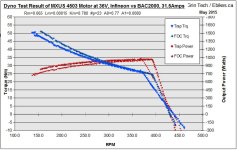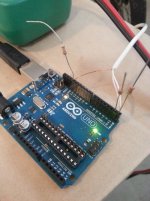Also, on the subject of the BAC2000 controllers. I did some more tests similar to what I'd done earlier on the BAC500 units, directly comparing the measured motor performance of the field oriented controller with a roughly equivalent 12mosfet infineon trapezoidal drive. In this case I used the V2 MXUS 3 turn motor as the control hub in order to run at a decently high RPM. The 12 fet infineon controller had a 31.5A battery current limit, so I set the motor power rating in the BACDoor software to produce the same 31.5A battery current rollback.
Here it is at 36V

And at 48V
I was surprised to find that in this case no field weakening setting was required to make the unloaded RPM's match the trapezoidal case, it seems that the current firmware from ASI does this automatically as the default behavior.
At the high end of the speed range that the BAC2000 FOC has a much stiffer relationship between the RPM and load. In the 48V test case, while both motors unloaded are at about 575 rpm, once there is 20 Nm of load torque, then the MXUS motor driven with the BAC2000 slows down to about 540 rpm, while the infineon controller slows down almost twice as much to 518 rpm. So you'll get noticeably less speed drop when you hit hills running the FOC.
The performances are then fairly similar when both controllers are current/power limited at 31.5A, but as the motor slows further and further below about 350rpm then once again we see the FOC produce more torque and power output of the motor for the same input. In this case it's an extra 75-100 watts or so of motor power towards the end of the tests.
Here it is at 36V

And at 48V
I was surprised to find that in this case no field weakening setting was required to make the unloaded RPM's match the trapezoidal case, it seems that the current firmware from ASI does this automatically as the default behavior.
At the high end of the speed range that the BAC2000 FOC has a much stiffer relationship between the RPM and load. In the 48V test case, while both motors unloaded are at about 575 rpm, once there is 20 Nm of load torque, then the MXUS motor driven with the BAC2000 slows down to about 540 rpm, while the infineon controller slows down almost twice as much to 518 rpm. So you'll get noticeably less speed drop when you hit hills running the FOC.
The performances are then fairly similar when both controllers are current/power limited at 31.5A, but as the motor slows further and further below about 350rpm then once again we see the FOC produce more torque and power output of the motor for the same input. In this case it's an extra 75-100 watts or so of motor power towards the end of the tests.


